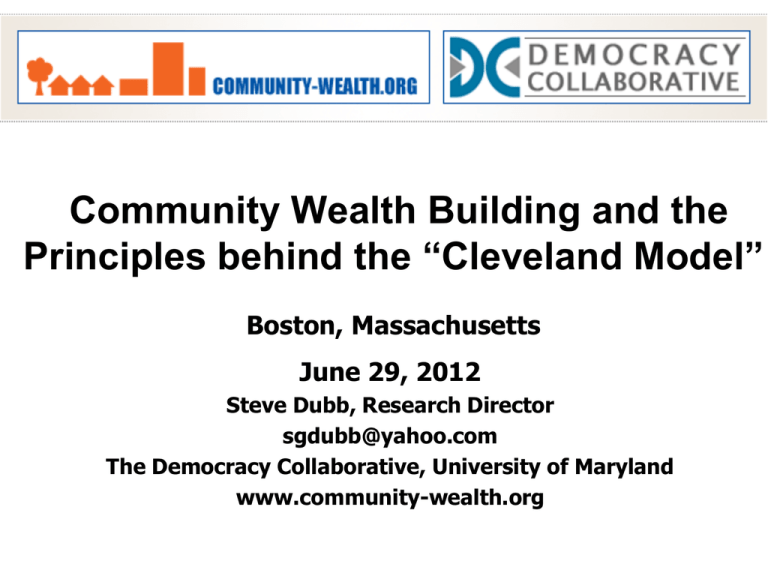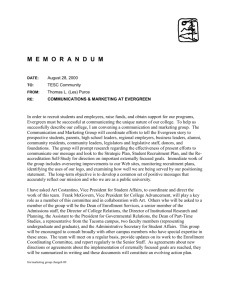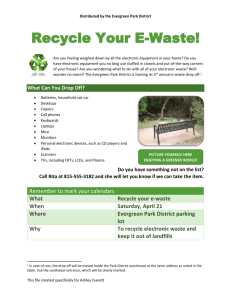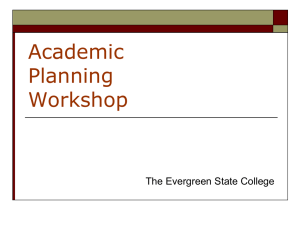3. Evergreen Cooperative Development Fund
advertisement

Community Wealth Building and the Principles behind the “Cleveland Model” Boston, Massachusetts June 29, 2012 Steve Dubb, Research Director sgdubb@yahoo.com The Democracy Collaborative, University of Maryland www.community-wealth.org About the Democracy Collaborative • Established in 2000 to advance a new understanding of democracy for the 21st century and to promote innovations in community development that enhance democratic life. • Conduct research, training, policy development, and community-focused work designed to promote an assetbased paradigm and increase support for the field. • Maintain community-wealth.org information portal. • Current flagship project: Evergreen Cooperative Initiative in Cleveland, Ohio, a comprehensive wealth building effort in six low-income neighborhoods. What is Community Wealth Building? • • • • • • • promotes common ownership of productive assets anchors capital and jobs locally stops the leakage of dollars from communities supports individual and family wealth building generates revenues to finance public services leverages anchor institutions for community benefit contributes to local economic stability Continuum of Wealth-Building Strategies BROADENING OWNERSHIP OVER ASSETS AND CAPITAL Family Wealth Building –Individual Development Accounts Shared Equity –Community Land Trusts –Microenterprise –Limited Equity Housing Cooperatives –Family Self-Sufficiency Program –Deed restriction (inclusionary zoning) –“Baby Bonds” & child savings accounts –Mixed ownership (Market Creek) –Earned Income Tax Credit volunteer assistance programs –Alternatives to predatory lending –Nonprofit financial education programs The Democracy Collaborative –Program-Related Investments –CDC/CDFI equity investments or joint ventures –Community benefits agreements Community/Worker Ownership –Anchor institutions (eds, meds, churches, museums, libraries) –ESOPs or worker cooperatives –Consumer, producer, or purchasing co-ops –Credit unions –Community corporations –CDC or CDFI direct ownership –Social enterprises –Commons-based enterprises (e.g., Wikipedia, Creative Commons licenses) Public Ownership or Investment –Municipal enterprise –State & local venture investments –Public pension fund ETIs (economically targeted investments) –Public leases: land & transit development –Stock warrants in exchange for granting tax breaks (fair exchange) –Trustee ownership (e.g., Alaska Permanent Fund) www.Community-Wealth.org What is an IDA? Special savings account; savings are matched for the poor, up to a cap. May have multiple sources of matching deposits. Includes financial education component. May be started as early as birth; but current federal programs are much more restrictive. May be used for homes, education, and business capital. What is a social enterprise? Nonprofit-owned business. Business itself is often a for-profit (i.e., a forprofit subsidiary of a nonprofit organization. Business has a “double bottom-line”—must contribute to the “mission” of the nonprofit while earning a profit, or at least reducing program costs. What is a CDC? Community development corporations are locally based non-profits that promote investment in low and moderate income communities. Over 51% of board are community residents. Founded as part of civil rights movement, goal is to allow low-income residents to exert economic control over their communities. From practically no CDCs 40 years ago, there are now about 4,600 today. What is a CDFI? • Community development financial institutions include credit unions, loan funds, banks, and venture capital firms that finance development in low-income communities. • Many CDFIs were founded as part of civil rights movement to combat red-lining. • Mainly, but not exclusively, non-profit. • In 30 years, number of CDFIs has increased from under 100 to over 1,000. CDFI asset base has climbed from $2 billion in 1999 to over $40 billion today. What is an ESOP? • Tax advantaged retirement plans for employees. • Invest primarily or exclusively in the stock of the employing company. • Can borrow money. • May own anywhere from a tiny minority share to 100% of the company. • Are highly regulated “qualified employee pension plans.” What is a community land trust? • Non-profit in operation. Board typically consists of one-third residents, one-third non-resident community members, and one-third government officials. • Most have “shared equity” – residents have 99-year lease but land is held by trust, with gain in value split—for instance, residents may get 25% of the equity gain while trust gets the other 75%. • Limits on individual equity gains ensure affordability for future residents, making housing “permanently affordable.” • Extremely low foreclosure rates What is a cooperative? • Four key types: consumer, producer, worker, and purchasing. • All based on 1844 “Rochdale” idea of limited return to capital and “one member, one vote.” • Largest sectors in the United States are credit unions (90 million members) and electrical co-ops (40 million members). About 30% of total U.S. agriculture production is marketed by farmer cooperatives. • Many familiar businesses are co-ops: e.g., Ace Hardware, Nationwide, Associated Press (AP). • Key U.S. growth sectors today are purchasing co-ops (five-fold growth since mid-1990s), food co-ops (doubledigit annual growth), and worker co-ops. What is public enterprise? • Direct enterprises are businesses owned & operated by government. Leading municipal types include public power companies, cable/broadband companies, and methane-recovery businesses. • Asset leveraging strategies that use land holdings to generate lease revenue to finance city services or support transit-oriented development. • Public-private partnerships such as city-owned convention center hotels are another form • investment strategies such as state and local venture funds and economically targeted investments by pension funds. An Integrated Community Wealth Approach Key Components Individual wealth building Community ownership Anchor Institutions Putting the Pieces Together • Create culture of wealth building and ownership at the individual level • Create community owned enterprises that provide living wage jobs and anchor business in low-income communities • Link community businesses with anchor procurement needs What is an Anchor Institution? • “Sticky capital” that doesn’t get up and leave • Typically among the largest employers in most major metropolitan areas • Local economic engine: employs large numbers of people; purchase large amounts of goods & services • Vested interest in surrounding communities • Typically non-profit: has public mission • Largely untapped potential 14 Ways to Leverage Anchor Institutions Sources of Leverage $1 trillion a year in purchasing power, 5% of all employees Real estate, endowment assets Research & technical expertise Available Means • Use of endowments • Employment policies • Local purchasing • Real estate investments • Technical assistance • Business incubation • Non-profit support work Potential Benefits • Revitalized neighborhoods • Increased local hiring, livable wages • Affordable housing • New retail development • Small business expansion • Increased nonprofit capacity 15 Examples University of Pennsylvania (Philadelphia) Tripled local purchasing from $20.1M in 1996 to $70M by 2005 (now exceeds $95M), while helping reduce local area crime rates by 40% and spurring $370M in private investment Henry Ford Hospital (Detroit) • Incentivized local hiring (7% of exec bonuses linked to these goals). • Pays local vendors a month in advance to provide working capital. • "Live Local, Buy Local, Hire Local" initiative Sinai Health System (Chicago) • Renovated Hollenbach Sausage Factory brownfield site ($7M project). 12K sq ft. building now houses Center for Families and Neighbors. Catholic Healthcare West (San Francisco) • Community Investment Program provides low-interest loans: Since 1992, $49 million lent out to 88 different nonprofit organizations. Community Wealth Building in Cleveland Understanding the Context PROPERTY AT RISK OUR STRATEGY 1. Focus growing portion of $3B in anchor institution purchasing locally 2. Create new for-profit, worker-owned businesses (percent of profits recycled in revolving loan fund to seed more businesses). 3. GREEN 4. Link to expanding sectors of the economy (e.g., health, energy, food, waste & green technologies) 5. Ensure financing and management to move to scale Getting Started • • • Begin a Conversation: Bring together about 50 “thought leaders” from diverse organizations — business, unions, co-ops, ESOPs, labor, religious, university, hospitals, community groups — along with city and county officials to have a conversation Develop a Strategic Plan: No quick way to do this — over 100 interviews of “decision makers” both at anchor institutions & in the community. And be prepared to listen to the results! Assemble a Team: Recruit leaders in business planning & employee ownership, community finance, workforce development, community land trusts, etc. 19 Green Businesses Suggested by Anchor Institution Interviews • • • • • • • • • • • • Shuttle service to reduce driving Environmentally friendly industrial-scale laundry service Environmentally friendly energy & facility upgrade business Green friendly practices in food service (recycled cutlery,etc.) Business that will separate out non-hazardous medical wastes away for recycling Solar panel installation on rooftops Recycling service that meets privacy standards so that confidential paper can be recycled Deconstruction (reuse of materials for building construction) Locally grown organic produce that could be made available for sale in hospital & university cafeterias & restaurants Ecologically friendly landscaping business Tree farm Housekeeping service with non-toxic cleaning products 20 Launched in 2009-2012 1. Evergreen Cooperative Laundry (ECL) 2. Ohio Cooperative Solar (OCS) 3. Green City Growers Cooperative (GCGC) Secondary Cooperatives 1. Evergreen Business Services (EBS) Planning & Development Three to Four Next Generation Businesses in Pipeline (launch 2 per year); goal in five years: 10 business, 500 employee-owners 21 Customers: hospitals, nursing homes & hotels Ultimate goal: 10-12 Million Pounds Per Year ($4-5 million in annual sales) Employment Goal: 50 at full capacity, presently 21 Greenest Commercial Laundry in NEO Ohio 22 Financing for Evergreen Cooperative Laundry Senior debt: • First Merit (local commercial bank) 750,000 • Shorebank 750,000 • City of Cleveland 1,500,000 “Equity” (sub-debt through Evergreen Coop Development Fund) • New Market Tax Credits (~26% of $5M allocation) 1,300,000 • Cleveland Foundation (Evergreen Fund) 750,000 Working capital: • City of Cleveland (EDA/Dept. of Commerce) 200,000 • Common Wealth Revolving Loan Fund 250,000 Total 5,500,000 23 2010-11: Six installations ~ 500 kWh; more than 250 homes weatherized to date Employment at present: 22 Current sales: $800K (annual) long-term goals: 3MW solar capacity installed, $2.5M in sales a year, 75 worker-owners 110 kW – Engineered 89th/ Euclid Ave @ the Cleveland Clinic 24 1. $10 Million -BROWNFIELD & ECONOMIC DEVELOPEMENT AWARD (STATE BEDI) $10 Million Award - $2 M in grant & $8 Million in Loan - Committed 2. $18 Million New Market Tax Credits (NMTC) (Committed by PNC) 3. Evergreen Cooperative Development Fund - $1 Million (Committed) Employment goal: 35-40 40K SF DISTRIBUTION CENTER 3.25 ACRE GREENHOUSE 25 GOALS • Create new jobs for neighborhood residents in an employment desert (goal: 500 jobs in 5 years) • Anchor capital so it doesn’t get up and leave; Redirect the purchasing stream of area institutions so that they bring needed resources into low-income communities • Stabilize the low-income (area median income is $18,500) neighborhoods in East Cleveland neighborhoods ("Greater University Circle). • Promote asset accumulation and build individual & community wealth ($65K/8 years) • Have a favorable environmental impact • Stop $$ from leaking out of NE Ohio • Develop a replicable model for national impact Unique Features of the Evergreen Model • Community Reinvestment: Active attempt to leverage the purchasing stream of large institutional buyers to foster reinvestment in disinvested communities • Benefiting communities under-represented in worker co-ops: about 90 percent of our worker-owners are African American and roughly 50 percent of workerowners are ex-offenders • Explicit place-based strategy: Not just a business strategy; goal is to rebuild neighborhoods • Network of businesses: Borrowing from Mondragón, goal is to build a mutually supporting network of businesses. 10% of profits returned to common fund. • Green: Businesses created are all designed to be “greenest in class” EVERGREEN COOPERATIVE STRUCTURE GUC Initiative Transit-Oriented Development Education Housing Engagement Evergreen Cooperative Development Fund Evergreen Cooperative Corporation (ECC) Non Profit) ECC Board of Directors, 15 members, multistakeholder CDFI (for Profit) Structured Fund (non -Profit) Executive Cooperative Businesses (LLC subsidiary of ECC) CDE Committees: Audit & Finance Governance Strategic Planning Investment Evergreen Business Services Evergreen Real Estate Corp. (for Profit) (for Profit) (for Profit,) Accounting IT TA Human Resources Key Elements to Adapting Model to Other Cities • Project champion: Provide seed capital, raise capital, hire consultants, and “lead the team” • Business Development: Recruit democratic management, oversee business planning, and provide technical assistance • Community loan fund incubator: Host loan fund • Workforce development capacity: Screen, recruit and train workers (customized to business needs) • Local political buy-in: City assistance to obtain approvals and state & federal funding • Anchor backing: Commit to buy from communityowned business that meet quality standards General Lessons • Identify and develop assets. • Develop community approaches leading to regional impact. • Use inclusive approach to decision making. Listening and follow-up are key. • Build leadership. Work to develop vision even when the resources seem unavailable. • Be prepared to adjust your vision to build a broader coalition. Know what you don’t know. Partnerships are key to getting things done. What Evergreen’s Worker-Owners Say “Because this is an employee-owned business, it’s all up to us if we want the company to grow and succeed. This is not just an eighthour job – this is our business.” – Keith Parkham “I never thought I could become an owner of a major corporation. Maybe through Evergreen things that I always thought would be out of reach for me might become possible. Owning your own job is a beautiful thing.” – Medrick Addison Thank you. Questions? Steve Dubb Research Director The Democracy Collaborative sgdubb@yahoo.com www.community-wealth.org




